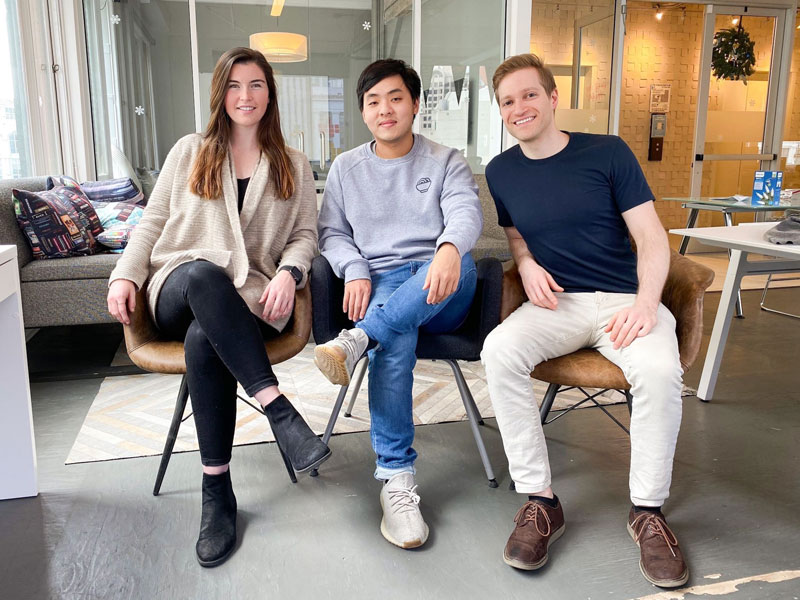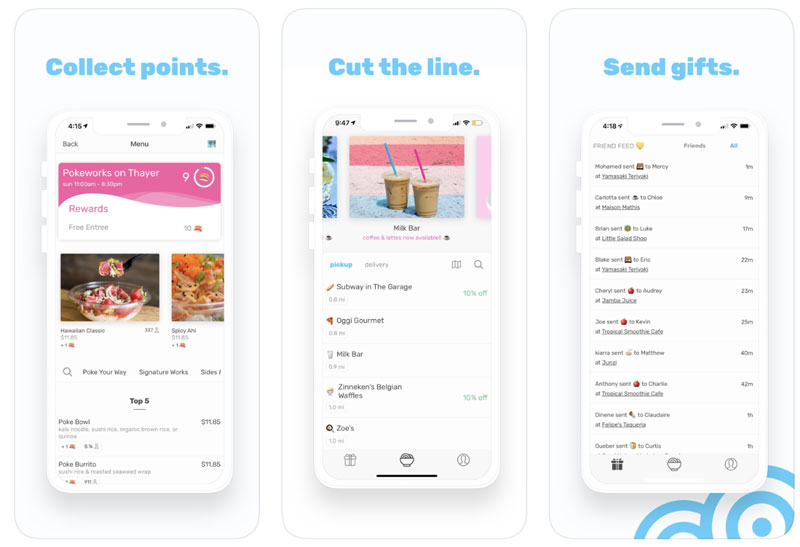If online banking now has a social media function to see which of your friends are sending money to each other, why shouldn’t meal ordering join the party? That’s the basic concept at Snackpass, a three-year-old app designed by Yale students that helps fellow students save time and money by ordering meals and coffee ahead of time, and then bypassing the line once they arrive.
Taking the order-ahead concept a step further, Snackpass lets users see what items their friends are ordering and from where, with the ability to give rewards points to their beloved associates who want to check out the same restaurants. For merchants on Snackpass, it’s an easy way to juice traffic from their nearby student populations at a smaller cost than promoting their restaurants on third-party delivery platforms.

Snackpass founders
“We are Gen Z as a brand, and that positions us to connect with Gen Z for the consumer base,” said Ben Rubenstein, head of biz ops, partnerships and expansion at Snackpass. “Every order is a mini referral, so it’s a real ecosystem of free marketing and truly organic, so we can really connect with the consumers and drive that additional usage to the restaurant.”
Outlining a typical customer journey, Snackpass Co-founder and Chief Operating Officer Jamie Marshall said users open the app and are brought to a home screen that includes trending restaurants and specific discounts, with high-quality photography that lets users scroll through a list of restaurants in the vicinity that are ranked by proximity.
Credit card information is saved in the app, along with favorite recent orders, meaning that repeat users can reorder their usual coffee or meal order with a few quick taps. After submitting the order, users see a countdown that tells them when to arrive at the restaurant and where to look for a bright blue Snackpass pickup station for their waiting order.
Billed as a mashup of Snapchat and the Starbucks app—or Venmo meets Tinder—Snackpass quickly captured nearly 80 percent of undergrads at the Yale campus in New Haven, Connecticut, but has since expanded to 20 of the largest campuses in the U.S., with the goal of hitting 100 colleges over the next few years.
Customers then receive reward points, like a digital punch card, with bonus points they can send to friends they think would be interested in the same restaurant or menu items. With the ability to see all the points users are sending back and forth to friends, the user experience is closely related to Venmo, which lets friends browse financial transfers among their closest contacts.
“We really tried to design the app so it doesn’t feel like any classic food app,” Marshall said. “We want it to feel more like that Snapchat, a really fun design feel.”
While Snackpass isn’t formally partnered with universities themselves, the company hopes to partner directly with schools in the future to get those high-dollar meal plans integrated into the service.
Restaurants on Snackpass are charged 7 to 10 percent of the order, which Marshall said depends on the maturity of the individual market, but “much lower than those delivery fees of 30+ percent commission.”
While Instagram and Facebook have normalized the concept of sharing what you’re eating with friends, for better or worse, the concept of socialized meal ordering isn’t a new idea in some more advanced markets outside of North America. Rubenstein said it’s already a “$100-billion-plus” concept in China, with the implication that Snackpass could be the spark to light this fire in the Western Hemisphere.
For prospective restaurants, Snackpass is more than just a high-tech takeout platform. The company has expanded its offering to include digital menus via QR codes, as well as a contactless payment solution that is a benefit for both customers and restaurant employees during the pandemic. The company doesn’t deliver any meals, but Rubenstein said that it’s exploring delivery options in certain markets.
While urban density has been upended by COVID-19, Marshall said the company is already looking to expand its service to city centers outside of campuses, which is natural since many college grads move to urban centers after graduation.
“We have students over the last three years now in Boston, Chicago, New York, San Francisco [and] Atlanta requesting us to please bring Snackpass … so we can use it and still be connected to all of our college friends,” she said. “It’s really exciting that we will hopefully be able to launch in cities over the next few years and bring Snackpass to those walkable areas, as well.”
For now, the company sees mom-and-pop, independent restaurants near college campuses as its prime opportunity, with retargeting and upselling leading to a claimed 30 percent increase in order volumes in best-case scenarios.
Investors seem to agree, as the company received a $21-million Series A investment in late 2019. The company said it’s not currently in fundraising mode after that windfall, which has allowed it to increase its headquarters team to 30.
Asked if the company might diversify beyond restaurants into retail, Rubenstein said “there’s a huge presence of what our brand can mean.”
Thinking back to my own college days, I would have been very interested to see who was getting the best deal at nearby liquor stores. While humans have an inherent pack mentality, it remains to be seen whether graying adults will have the same affinity for sharing their culinary whereabouts and discounts among friends.
Looking at my Venmo feed, I see my friend Shawn paying a friend for lunch and Eric sending his wife cash for some mom jeans. Is this the future of restaurant pickup? Stranger things have happened, and this guy isn’t betting against peoples’ proclivities to share the most mundane details of daily life.
And in case you’re wondering, I’m about to pay my electric bill and am feeling very ¯\_(ツ)_/¯ about the whole thing. Tell your friends.


